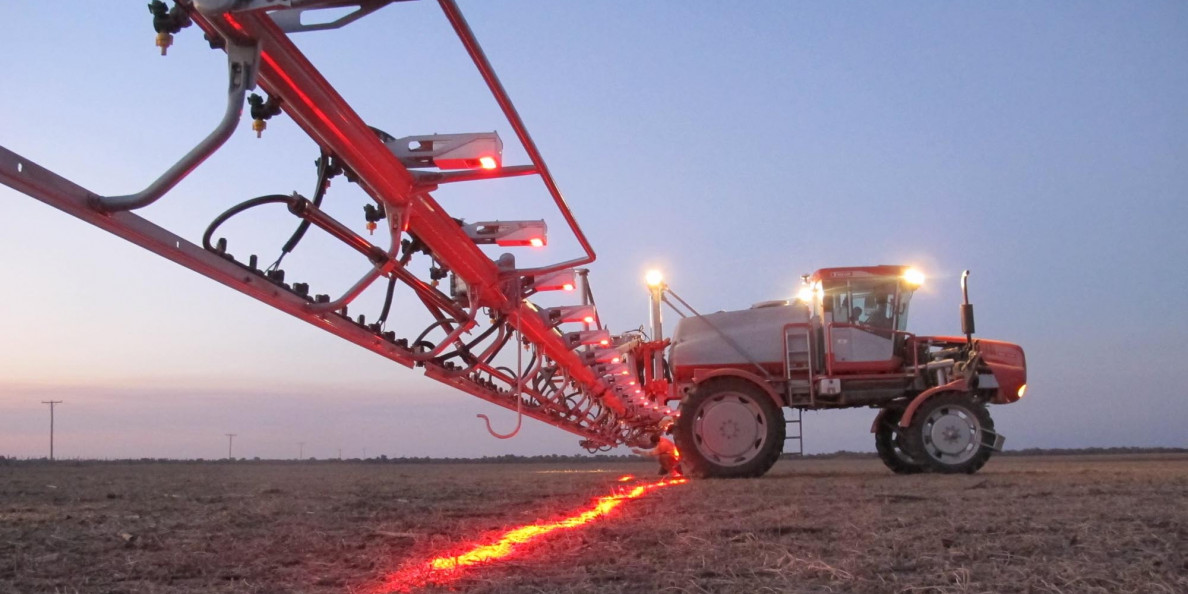The trailers of chemicals rolling onto Derek Schafer’s farm are drastically lighter. The eastern Washington producer just shaved $70,000 off his herbicide bill in a single year.
If it’s green, it goes. A new weed technology uses a combination of infrared, sensors and nozzles to detect plants and aim a blast of herbicide at a spot the size of a nickel. WEEDit is an automatic plant detection technology that allows chemical application solely to green matter, rather than spraying bare dirt, all while the sprayer rolls at 15 mph, light of day or dark of night.
https://www.youtube.com/watch?time_continue=37&v=JOdj6ivDel8
The sensors use fluorescence to detect live plants and only activate the solenoids that are on target for a given weed. Similar technology has been available in the past, but required constant operator calibration. WEEDit self-calibrates 50 times per second, a chasm of difference from older systems. “This is like an iPhone compared with an old desktop computer. It’s a complete technological leap forward,” Schafer describes.
Originating in the Netherlands and available in the U.S. since April 2017, WEEDit can be installed on any sprayer, says Adam Hutton, managing director of AgriTech America: “The componentry and brackets retrofit existing sprayers. We’re in the middle of talks to provide WEEDit-dedicated sprayers.”
Rather than blanket spraying a field, WEEDit nozzles only activate when plant matter is detected, and according to Schafer, the input savings have made a dramatic difference on his Adams County operation. “On my farm, this is the one thing that’s provided instant gratification on payback. Buy a better combine or tractor and you’ll save ‘x’ in efficiency over time, but it’s not concrete. WEEDit savings were an immediate reality for me and my chemical bill is just not the same.”
The WEEDit system costs approximately $100,000 on an 80’ boom. Schafer runs a 100’ boom and pencils a complete payback in two years. Across his wheat, pea and canola acreage, Schafer faces increasing weed resistance issues. In 2017, he used the WEEDit system mainly on fallow ground, but also during pre-planting and post-harvest, and estimates 90% savings on herbicide costs. “I don’t want to spend $5 to $10 per acre for broadcast sprays. I was able to take an expensive $40 per acre chemical mix and spray it for $4 per acre,” he says.
“I put 60 gallons of glyphosate in my John Deere 4730 sprayer fitted with WEEDit and it operated for two days. I put 60 gallons in my normal field sprayer to broadcast and was empty in two hours,” he adds. “The savings are pretty easy to see.”
With rolling hill farmland, Schafer runs his system at 8-10 mph and says operation is simple: “If you have no tech savvy, you can still run this with no problem.”
“It’s a one-button start-up,” Hutton echoes. “Make sure chemicals are loaded, the pump is on, and just drive. It’s a self-sufficient technology and requires no assistance from the operator. At night, the system will be equally accurate because it’s using a red light source.”
Scott Arthaud grows no till corn, grain sorghum, sunflower and wheat in the Oklahoma Panhandle and began using WEEDit in June, primarily on fallow ground that received unusually high amounts of rainfall in 2017. “Normally it would have taken far more high-dollar chemicals to control the weeds with this much rain and my fallow acres might have even needed to be plowed. I was able to hold my chemical inputs in check and next year I really anticipate my chemical bill going down as I use the system from the beginning of season.”
Arthaud estimates WEEDit used only 20% of the chemical volume normally applied to his fields during broadcast applications. “The only learning curve was what mix of chemicals to apply,” he says. “The operation was very simple and my 14-year-old son was trained in an hour.”
Hutton expects herbicide savings to range between 85% to 93%. If a given burndown mix (depending on the brew of chemicals) costs $8 per acre, Hutton says WEEDit can save roughly $7.20 per acre: “It looks expensive at first, but it’s not when you run the numbers and look at ROI over several years.”
“I can only say what I’ve seen on my farm, but we saved $70,000 in chemicals for 2017,” Schafer concludes. “We spray all summer in a fallow system and it’s been a very impressive payback.”


